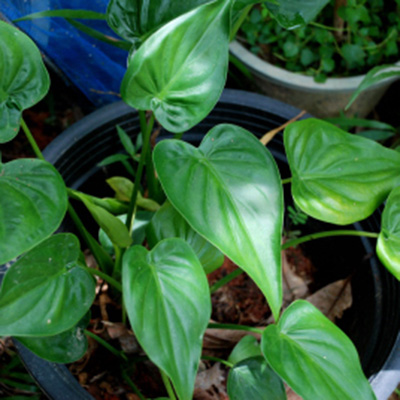Araceae-Alocasia-cucullata
Classification
- Botanical Family : Araceae
- Genus : Alocasia
- Epithet : cucullata
- German Family Name: Aronstabgewächse
- English Name: Hooded Dwarf Elephant Ear, Chinese Taro
- Thai Name: ว่านนางกวัก
- Thai Phonetic: wan nang kwuang
- Author: (L.) G. Don.
Water Requirements
Plant Type
Light Requirements
Cultivation
Alocasia cucullata is a evergreen plant of low groth. The plant eventually forms a nice thick clump approximately 1 metre tall by 1 metre wide. Usually the plant becomes multi-stemmed even when quite young.
The plant has beautiful glossy dark green heart-shaped leaves on long petioles.
The unusual leaves give it its common name of ‘Hooded Elephant Ear’. In Asian countries, the plant is often called ‘Buddha’s Hand’. Residents in Thailand place the plant in their front doors, and when the wind blows, the leaves are like Buddha's hand, waving good luck and fortune into the home.
The plant can grow with full sun, partial shade or even flourish in shade. The soil should always be kept moist.
Suitable as an indoor and container plant too.
Propagation: By dividing corms
Alocasia cucullata ist eine immergrüne Pflanze von niedrigem Wuchs. Die Pflanze wird zwischen 0,50 m und 1 m hoch. Die Pflanze bildet Mehrstämmigkeit aus, auch wenn sie noch jung ist.
Sie hat sehr schöne glänzend dunkelgrüne herzfömige Blätter an langen Blattstielen. Die aronstab-typischen Blüten zeigen sich sehr selten. Sie haben einen weißen Kolben und eine weiß-grünliche Spatha.
Die außergewöhnlichen Blätter geben der Pflanze den englischen Namen "Kapuzen Elefanten Ohr". In Asien wird die Pflanze auch "Buddhas Hand" genannt. In Thailand stellt man die Pflanze oft in die Nähe der Haustür und wenn der Wind weht, dann sehen die Blätter aus wie Buddhas Hand, die das Glück in das Haus winkt.
Sie kann bei voller Sonne, wie Halbschatten oder auch hellem Schatten gedeihen. Der Boden sollte stets feucht gehalten werden.
Alocasia cucullata eignet sich für den Garten wie auch als Topfpflanze für drinnen und draußen.
Alocasia cucullata ist giftig, ebenso wie andere Vertreter dieser Gattung, weil sie Kalziumoxalatkristalle enthalten. Alocasia cucullata sollte nicht mit Alocasia esculenta verwechselt werden, was essbar ist.
Vermehrung: durch Abtrennung der Tochterknollen
Origin
Miscelaneous
Ethnomedical uses
The ethnomedical information is provided for general information only, it is not intended as guidance for medicinal use.
Northeast Asia, Volume 4, page 135 of Part 4 Takeatsu Kimura, Unesco
Volksmedizinische Verwendung
Die Berichte über volksmedizinische Verwendung ist nur zur allgemeinen Information und nicht als medizinischer Ratgeber zu betrachten.
Wird in China verwendet bei: Schlangenbiss, Bronchitis, Fieber und Leptospirose. (1)
Northeast Asia, Band 4,Teil 4 S. 135 von Takeatsu Kimura,Unesco


